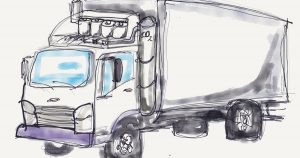The village of Sagara B sits along a red dirt road in the baobab-dotted Dodoma region of central Tanzania, where half-desert savanna meets the Rubeho mountains. It’s home to less than 5,000 people and is so remote no one ever bothered to set up an internet connection. Until four years ago.
Over a week, engineers from Copenhagen-based company Bluetown erected an 80-foot Wi-Fi tower topped with shiny solar panels and a microwave link antenna. It connected to a fiber backhaul 15 miles away, creating a half-mile-wide hot spot with download speeds up to 10 Mbps—fast enough for Netflix. Villagers rented smartphones from the company and paid 50 cents per gigabyte for the data they used, just over 1 percent of the average monthly income. And just like that, life began to change.
“You can see that something happened with the internet,” says Danish photojournalist Lars Just. “The world sort of opened up.”
As of 2018, more than half of the world’s 7.7 billion people had access to the internet. Africa has seen huge growth, with the percentage of residents online increasing from 2.1 in 2005 to 24.4 last year. In an attempt to connect the rest—not just to the web, but to its proven socio-economic benefits—the African Union and World Bank recently launched Moonshot Africa, an initiative to double broadband access on the continent by 2021, and make it universal by 2030.
The challenges are as big as the continent itself. Those offline often can scarcely afford food, much less expensive data packages. They tend to live in rural areas without existing fiber-optic lines, cell towers, or routers. Telecoms don’t invest because of the high capital expenditure and low potential revenue. Governments sometimes lack the resources to bridge the gap and are slow to enact policies fostering growth.
“In many places, it takes public and private resources to improve connectivity,” says Darrell West, director of the Center for Technology Innovation at the Brookings Institution. “Areas that are extremely poor or lack sufficient population density likely will need government resources or incentives to get wired.”
Bluetown—helmed by an ex-Nokia Denmark executive—has found an innovative way to reach this market, bringing nearly 1,000 villages in Tanzania, Ghana, Rwanda, Mozambique, and India online since 2014. The company circumvents the cost of pricey, high-power hardware with a green energy setup it now delivers in three IKEA-like boxes. Installation costs one-tenth of a standard 3G base station, and the system runs on free, unlicensed bands like 2.4ghz, 5.8ghz, and TV White Space. The company doesn’t profit much from selling data, so instead it boosts revenue by selling content distribution services to local organizations via a local cloud, providing articles and videos about agriculture, education, government, and healthcare free to users.
“Four billion people don’t have access to the internet,” says Emil Damholt, Bluetown’s impact manager. “It’s not low-hanging fruit, for sure, but the potential is massive and that’s what we’re going after.”
After hearing about Bluetown’s model a couple years ago, Just contacted the company, and they invited him to shoot its second Sagara B installation. He flew from Copenhagen to Dar es Salaam, boarded a plane west to Dodoma, then took a Land Cruiser three hours east, his driver speeding down dusty, bumpy roads so fast the vehicle occasionally went airborne. On arriving in Sagara B, he visited the mast—easily the tallest thing in town—and FaceTimed his wife. “She took a screenshot and put it on Instagram, because it was so great to her,” Just says. “She’s used to me being somewhere where we can’t talk for three days.”
Just photographed internet use in the village over three days, guided by a local named Titus who helped maintain the equipment. Some 250 villagers had rented smartphones from Bluetown, from a tailor who began using WhatsApp to communicate with clients, saving him countless trips to the city, to a teacher who started relying on YouTube to check his English pronunciation. But it also has its critics. One woman Just met complained her husband spent too much time on Facebook and her daughters didn’t help as much with the housework anymore.
In an unfortunate twist, Bluetown couldn’t scale its business in Tanzania due to a difficult regulatory environment. Earlier this year, it handed over its operations at nine sites to Mobiwire Tanzania. It’s now focusing on India, where it’s already connected more than 750 villages, and Ghana, where it’s partnering with Microsoft to bring internet to 800,000 people—many in places as far-flung as Sagara B.
More Great WIRED Stories
- Everything you need to know about genetic testing
- The strange life and mysterious death of a virtuoso coder
- Alphabet’s dream of an “Everyday Robot” is just out of reach
- Wish List 2019: 52 amazing gifts you’ll want to keep for yourself
- How to lock down your health and fitness data
- 👁 A safer way to protect your data; plus, the latest news on AI
- 🏃🏽♀️ Want the best tools to get healthy? Check out our Gear team’s picks for the best fitness trackers, running gear (including shoes and socks), and best headphones.



